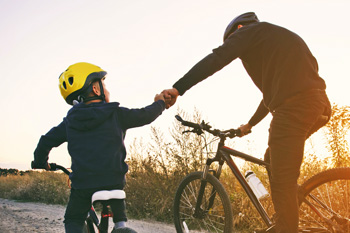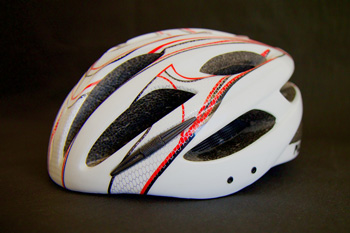Youth Helmet Safety

Wear a Helmet
Helmet Safety Guide
- Finding the Right Helmet


Finding the Right Helmet
Choosing a quality helmet can help reduce injury risk, but which helmet should a child use?
Not all helmets are the same. They are designed for different activities and may not protect the head in all situations. Bicycle helmets are made specifically for bicycling and are manufactured according to federal safety standards, whereas other types of helmets may only be made to voluntary safety standards. Since 1999, all bicycle helmets must meet the standards of the U.S. Consumer Product Safety Commission (CPSC) to provide protection against skull fractures and severe brain injuries. Check the applicable standards for bike and other types of helmets at the CPSC website.
Be aware that unsafe or counterfeit helmets that do not meet safety standards exist and are often sold online. CPSC-certified helmets should contain a sticker on the inside that includes information on its compliance, including the month and year of its manufacture. Find the requirements for instructions and labels that should come with all CPSC-certified helmets.
Helmet Ratings
Researchers at Virginia Tech University have tested many types of helmets for their effectiveness in reducing concussions. Working with the Insurance Institute for Highway Safety, the researchers have rated more than 100 bicycle helmets. View the bicycle helmet ratings
Sizing a Helmet
Remember that helmets should be selected based on head size, not age! Follow the steps below to find the size of the helmet needed, and then see the table matching head size with helmet size.
- Using a soft measuring tape, place the tape above the eyebrows.
- Hold the tape in place while wrapping it around the head until the two sides of the tape meet.
- Write down the distance in inches. This is the head's circumference.
- Compare the measurement to the corresponding helmet size using the table below.
Head Circumference (inches) Bicycle Helmet Size (approximate) up to 18 1/2 inches X-Small (toddler) 18 1/2 inches to 20 7/8 inches Small 20 7/8 inches to 22 3/4 inches Medium 22 3/4 inches to 24 1/8 inches Large more than 24 1/8 inches X-Large Note: Manufacturers may have different sizing and may combine sizes (e.g., Small/Medium, Medium/Large). Source: Helmets.org Buying a Helmet


When buying a helmet, let children pick out their own; they will be more likely to wear them for every ride. If buying in the store, be sure to have children try on the helmets according to the steps in the Fitting and Wearing a Helmet section below.
The Indiana University School of Medicine has a Safety Store that offers high-quality, low-cost child safety products and free injury prevention education. Located at the Riley Hospital for Children in Indianapolis, the store sells bicycle helmets, which can also be ordered online.
- Fitting a Helmet
Fitting a Helmet
How to Fit a HelmetIn general, helmets should sit snugly and comfortably on the head all the way around, sitting level and stable enough to stay in place during crashes. There should be no spaces between the head and the helmet foam. Buy a helmet that fits the child's head now, not a helmet to “grow into.” Follow the steps below to wear a helmet properly.
How to Fit a HelmetSteps to Fit a Helmet
- Make sure the bottom of the helmet is only one or two finger widths above the eyebrows. The helmet should be level and low on the forehead (not tilted), and the back of the helmet should not touch the top of the neck.
- On each side of the helmet, adjust the side straps so the front and back straps form a V shape underneath and slightly in front of the ears. Lock the slider if present. You may find it easier to do this with the helmet off.
- Adjust the chin strap buckle so it is centered below the chin. You may find it easier to do this with the helmet off.
- With the helmet on, make sure the helmet is still low and level, and then buckle the chin strap. Tighten the strap until it is snug enough that only one or two fingers can fit between the chin and the strap.
- Have the child open his or her mouth like yawning. The helmet should pull down on the head. If it does not, then tighten the chin strap.
- Check that the helmet does not rock back and forth or side to side more than an inch. If it does, then shorten the straps and retighten the chin strap and test again.
- Have the child look up and side to side. The child should be able to see the front of the helmet when looking up, and the helmet should not obstruct any vision. If the helmet cannot be seen, then it is not low enough. If it obstructs vision, then the straps should be readjusted.
- Ask the child how the helmet feels. It should feel snug but not too tight. If the helmet has removable padding or a universal fit ring, adjust as necessary.
Helmet Fit Downloads
- Resources
More Bicycle and Helmet Safety Resources
